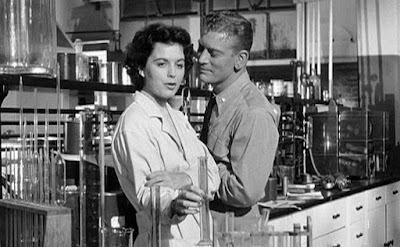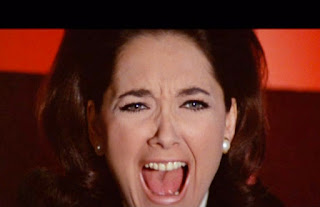 |
| "Thanks for all your help Rosie. Go ahead and clock out -- your last check is in the mail." |
An interesting exception to the rule was the B sci-fi movie. Capable, courageous female scientists and doctors popped up time and again to help battle giant radioactive monsters or menaces from outer space.
Undoubtedly, the presence of women in lead roles added a romantic angle that had potential appeal for adult audiences. The women spent almost as much time fending off the awkward advances of their male colleagues as battling monsters (more on that below).
Perhaps too, their presence was a subtle acknowledgement that while men got us into this atom age radioactive mess, women were needed to help get us out of it. Whatever the motives, conscious or unconscious, these unassuming films went against the cultural grain and set the stage for the normalization of women’s achievement outside of home and family.
The following list of profiles in B movie courage only scratches the surface of strong female characters in ‘50s sci-fi. This time around I’ve limited it to women scientists and doctors with key roles -- even at that, it’s a selective list. Not included are the pioneering female astronauts, or, for that matter, the “ordinary” single women, wives and mothers who faced extraordinary sci-fi threats. I’ll take those up in future posts.
Along with each character’s resume and screen accomplishments, I’ve included a “cringe moment.” This was the ‘50s after all, and being subjected to chauvinistic acts and comments was the price women paid for inclusion in the monster fighters’ club. These vignettes serve to illustrate how far we’ve come, at least as far as the depiction of “normal” male-female relations in popular culture is concerned.
 |
| "Hey mister, I've got a bone to pick with you!" |
Biggest screen moment: Nuclear scientist Tom Nesbitt (Paul Hubschmid) approaches Elson and Hunter with a wild story of seeing a huge prehistoric creature unleashed by a polar atomic test. Elson is completely dismissive, but Lee keeps an open mind, showing Nesbitt illustrations of dinosaurs to try to identify what he saw. After a fishing trawler is capsized by what witnesses insist was a sea serpent, Lee suggests they show the set of pictures to one of the survivors in a sort of creature line-up. When the sailor picks the same dinosaur as Nesbitt, Elson becomes convinced, and they arrange an expedition to track down the monster.
Biggest cringe moment: When Nesbitt and Hunter are alone discussing what he might have seen, he awkwardly tries to flirt with her:
“Funny, a girl like you, a paleontologist…”
“What’s wrong with paleontology?”
“Classifying old bones…”
“Old bones? If we didn’t study the past, you wouldn’t know anything about the atom. Dr. Elson says the future is a reflection of the past…”
Additional notes: After her role in Beast, Paula dived into TV, guesting on dozens of shows, including One Step Beyond, Perry Mason and The Man from U.N.C.L.E. She also appeared in two of the more obscure B sci-fi films of the ‘60s, The Flight that Disappeared (1961), and Hand of Death (1962; with John Agar).
Resume: Along with her father, Dr. Harold Medford (Edmund Gwenn), Pat is part of a scientific team sent by the Dept. of Agriculture to help the authorities in New Mexico investigate a series of mysterious deaths in the desert near the White Sands atomic test area.
 |
| "I told them it was a bad idea to have a picnic out here in the middle of nowhere!" |
“Look Bob, there’s no time to give you a fast course on insect pathology, so let’s stop all the talk and get on with it!”
Her presence is indeed crucial, as she discovers that two young queen ants hatched and flew away before the nest was bombed. If they're not found and dealt with, it could be the beginning of the end for humanity.
Biggest cringe moment: Arriving in New Mexico on a military transport plane, Pat’s dress gets caught as she climbs down the ladder from the cockpit, revealing some leg. Standing on the tarmac, Graham and Peterson are ogling her.
Peterson: “She’s some doctor, huh?”
Graham: “Yeah, if she’s the kind that takes care of sick people, I think I’ll get a fever real quick.”
Additional notes: After Them!, Joan (who is still alive as of this post), acted in only a relative handful of movies and TV shows before retiring in the late ‘50s.
 |
| Prof. Joyce inspects the lab equipment as Pete makes his move. |
Biggest screen moment: Joyce and Carter are brought in by the Navy to examine a huge piece of irradiated tissue that was caught on the fins of an atomic sub during a mysterious encounter in the middle of the Pacific ocean. After extensive examination, the team concludes that it came from an octopus, but one so huge as to be beyond belief. Their theory is borne out as ships begin disappearing and a man on a beach is crushed by some enigmatic thing. After there is no doubt about the threat from the colossal octopus, Joyce, Carter and Cmdr. Pete Matthews (Kenneth Tobey) head up a task force to deal with the threat. When depth charges fail to kill the beast, it emerges from the depths to wrap its tentacles around the Golden Gate Bridge. In the situation room, Joyce calmly and authoritatively tells a Navy Captain to go to red alert.
Biggest cringe moment: Earlier, when the scientists are still trying to determine the source of the tissue, Matthews corners Joyce in the lab. She responds by egging him on:
“When you’re driving that atomic submarine of yours, do you have much time for romance?”
“Even if I did have the time, where would I find the opportunity? You know, women aren’t allowed aboard a submarine.”
“Poor boy, I thought the Navy was equipped for every contingency…”
Additional notes: In addition to It Came from Beneath the Sea, Faith starred in 3 other sci-fi movies released in 1955: Cult of the Cobra, The Atomic Man, and most memorably, This Island Earth (in which she also played a scientist).
 |
| "Hmmm, I can't tell for sure, but I think part of the problem is that knife sticking out of its chest." |
Biggest screen moment: With the help of colleagues Dr. William Arnold (Tod Andrews) and Prof. Clark (John McNamara), Mason digs up an unearthly, weirdly human-looking tree that has suddenly sprouted near their encampment. The natives warn them that it is the dreaded Tabanga, which has grown from the body of a young native man unjustly accused of murdering his own father, and executed by authority of the local witch doctor. A ceremonial knife is buried in the monster where its heart should be.
Back at the lab, Terry finds the monster has a pulse, but it’s weakening. Disregarding Arnold’s suggestion to let it die, she makes an executive decision to stimulate its heart (?) with an experimental serum of her own making -- a decision she will soon regret.
Biggest cringe moment: Arnold is mad about the good doctor Mason, and wants to make her his wife and take her back to civilization. He pleads with her:
“Terry, will you stop being a doctor first and a woman second? Let your emotions rule you, not your intellect.”
“Bill, I live by my intellect and my reason. If I let my emotions run away, I wouldn’t be any good in my work.”
Undeterred, Bill embraces her and they kiss. He asks her if she loves him.
“I don’t love you.”
“Then why did you kiss me back?”
“I don’t know, my metabolism… it’s unconscious, involuntary…”
Additional notes: The same year as From Hell It Came was released, Tina also appeared in The Man Who Turned to Stone, about a group of scientists who stay young by draining the life out of unsuspecting women.
 |
| Sally and Mitch go alien bird hunting. |
Biggest screen moment: When Mitch sees a UFO “as big as a battleship” shoot past his plane, no one believes him because the thing didn’t show up on radar. However, as more planes start crashing and reports come flooding in, it’s apparent that something big and dangerous is cruising the skies over North America.
Sally comes up with an idea to check photographs from weather balloons, and sure enough, a huge, buzzard-like bird shows up in a batch. After analyzing one of the monster's feathers found in the wreckage of a plane, physicist Karol Noymann (Edgar Barrier) concludes that the creature is from another galaxy, and has an anti-matter shield around it that makes it impervious to all weapons. (!!)
Caldwell uses her math expertise to help figure out a way to negate the shield. But her biggest “bad ass” moment comes when she and MacAfee discover the alien bird’s nest in a remote part of French Canada. There’s an egg in the nest, and they have to destroy it before another space buzzard hatches to terrorize the world. She picks up a rifle and aims. When MacAfee gives her a quizzical side-glance, she says matter-of-factly, “I’m from Montana…”
Biggest cringe moment: After they both survive a mid-air collision with the Giant Claw, MacAfee and Caldwell are called back to Washington. On the red-eye flight back east, MacAfee suddenly leans over and kisses her as she’s trying to get some shuteye. Caldwell is unusually composed:
Caldwell: “Where did that come from?”
MacAfee: “Left field maybe.”
Caldwell: “I like baseball… Speaking of baseball and left field, somebody warned me you made up your own rules.”
MacAfee: “Whoever said that is no friend of mine.”
Caldwell: “But he’s a friend of mine.”
Additional notes: Mara Corday’s other sci-fi role in 1957 was in The Black Scorpion. She teamed up with Richard Denning, playing an American geologist, to battle giant scorpions freed from their underground lair by a series of earthquakes.










